When does the bullfinch, also called bullfinch or blood finch, breed? How can the bird be recognized? And what does the young bullfinch look like? You can find this and other information as well as bullfinch pictures in our large profile.

The bullfinch (Pyrrhula pyrrhula) is a very conspicuous songbird, which, due to its colorful plumage, is also called bullfinch - derived from the red robes of the church canons - or blood finch. As the last name suggests, the bullfinch belongs to the finch family and is therefore well known to ours Chaffinches and Greenfinches related. Because of its brilliant colors, the bullfinch was caught and kept in cages for a long time. And even today there are breeders who trade in the animals, even if catching wild birds is of course forbidden in nature. You can find more exciting facts and pictures of the bullfinch here in our detailed species portrait.
contents
- Bullfinch: Wanted poster
-
This is how you recognize the bullfinch
- What is the difference between female and male bullfinches?
- How does the bullfinch singing sound?
- Which habitat does the bullfinch prefer?
- Where does the bullfinch build its nest?
- What do bullfinch eggs look like?
- When is the bullfinch breeding season?
- How do you recognize a young bullfinch?
- Where does the bullfinch spend the winter?
-
Support the bullfinch in the garden: this is how it works
- What do bullfinches eat?
- Which nesting aids are suitable for bullfinches?
- How can you additionally support the bullfinch?
Bullfinch: Wanted poster
| size | Approximately 15-18 cm |
| weight | About 25 g |
| Breeding season | May June |
| lifespan | Up to 8 years |
| habitat | Forests, parks and gardens |
| Feed preference | Seeds and buds |
| Threats | Decline in food and living space |
This is how you recognize the bullfinch
The bullfinch is one of the most conspicuous songbirds around. It has a compact, almost round shape, which has given it the name "Bullfinch" in English. Its back and shoulders are a light blue-gray that blends into black tips of wings and tail. The bull's head is adorned with a black cap that extends over the eyes and the short, powerful beak.
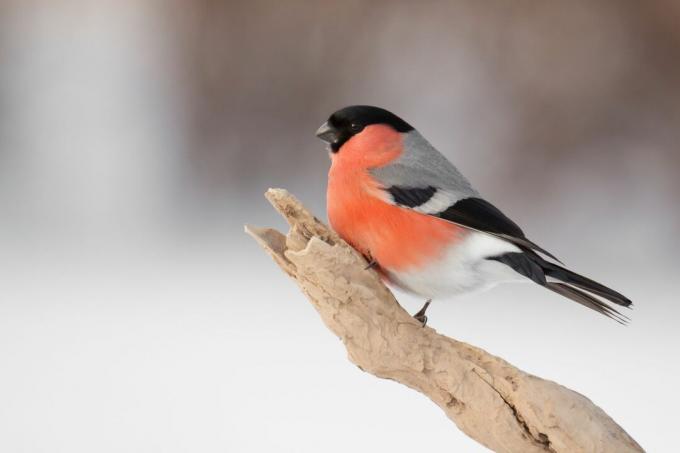
What is the difference between female and male bullfinches?
The distinction between male and female bullfinches is very easy compared to other songbird species. Because while the males present their typical orange-red chest and stomach area, the female bullfinches are rather inconspicuously olive-gray on the underside.
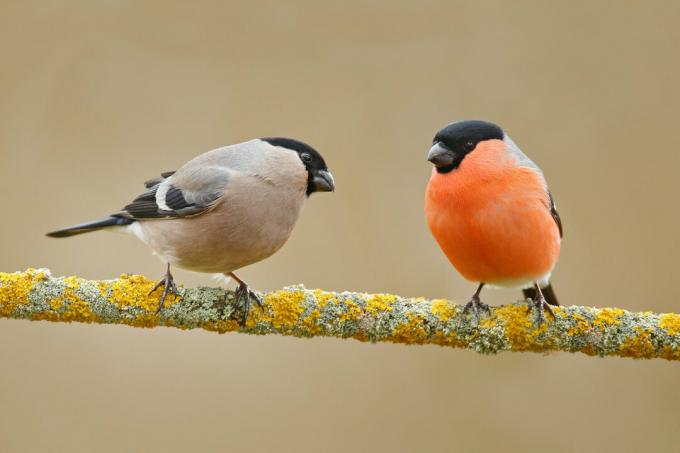
How does the bullfinch singing sound?
For such a powerfully built bird, the bullfinch has a rather soft song. This consists of a mixture of whistling tones, melancholy calls and the occasional choked, high-pitched tone. The singing of the bullfinch can often only be heard up close and often even goes unnoticed.
You can listen to the bullfinch singing in the following audio recording:
Which habitat does the bullfinch prefer?
Bullfinches prefer to live in dense coniferous or mixed forests. But they also feel at home in urban parks and gardens, as long as there is enough undergrowth and one or two coniferous trees available.
Where does the bullfinch build its nest?
The bullfinch usually builds its nest in a conifer or a bushy shrub. The nest is placed just a few meters above the ground and is very well hidden in the dense vegetation. It is erected as a kind of platform made of fine brushwood on branches.
What do bullfinch eggs look like?
Bullfinch females lay between four and six bluish to greenish eggs that are covered with dark spots. The eggs are laid on the nest platform in a bed of moss, fine stalks and feathers.

When is the bullfinch breeding season?
The breeding season of bullfinches lasts from May to June. After laying eggs, the female incubates the clutch for about 14 days and is provided with food by the male during this time. After hatching, the young bullfinches are born naked and blind and are completely dependent on the care of their parents for the first few days. After about three weeks they are fully grown and leave the nest. But even after this point in time, they stick to their parents for some time and are supported by them in their search for food.
How do you recognize a young bullfinch?
Young bullfinches are not yet as colorful as their parents. Even the male juveniles are - like their mothers - inconspicuously colored olive-brown. In addition, the young bullfinches still lack the black headgear of the adult animals. You can recognize the young blood finches by their compact shape, the shape of their beak and the dark tips of their tails and wings.
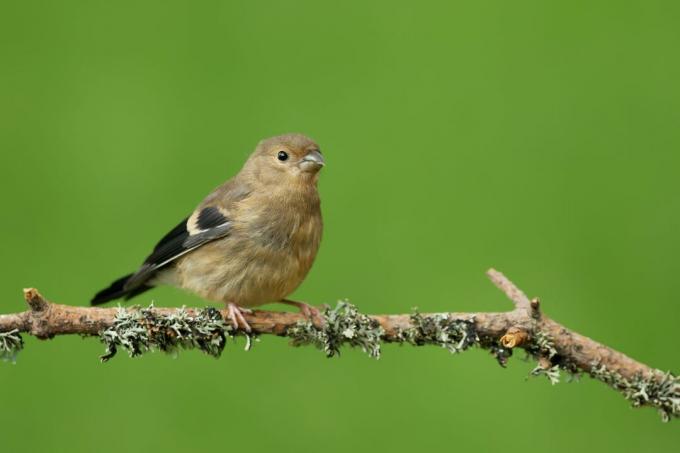
Where does the bullfinch spend the winter?
Bullfinches are chief Resident birds. They can be found in their breeding grounds all year round. In the late year, smaller family groups are often out and about together, roaming the countryside in search of food. Occasionally, however, female and young bullfinches move south and do not return to their breeding grounds until spring.
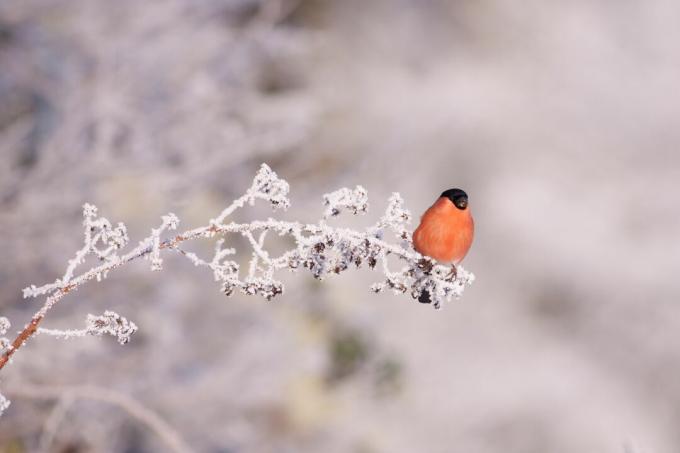
Support the bullfinch in the garden: this is how it works
The colorful bullfinches can also feel at home in your garden. Supportive measures such as a feeding station or suitable nesting aids facilitate the settlement of garden birds. At the same time, they provide a great opportunity Bird watching represent. In the following, you will find out what demands the bullfinch places on a potential home and how you can design your garden in a bullfinch-friendly manner.
What do bullfinches eat?
Bullfinches' diet consists mainly of vegetable seeds, buds and fruit kernels. During the breeding season, however, they also use animal food and hunt protein-rich caterpillars, snails and insects, which they then feed to their young.
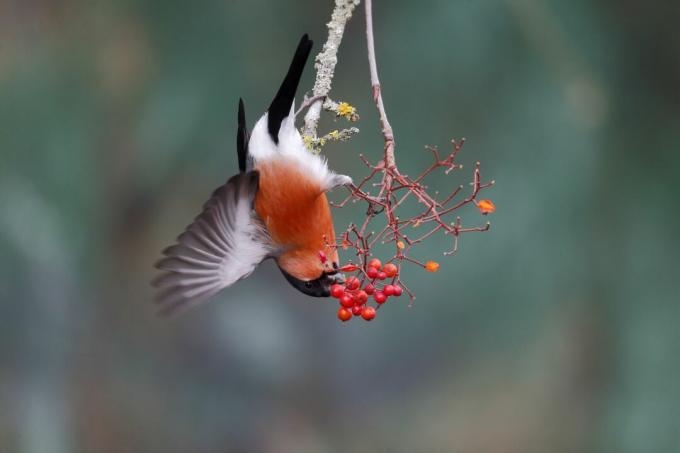
With a feeding station in the garden you can make it easier for the colorful songbirds to search for food. For example, ours is suitable for year-round feeding Plantura all year round feed with ingredients suitable for beaking and an extra load of protein and feed lime for the breeding season.
Which nesting aids are suitable for bullfinches?
As free breeders, bull monkeys do not accept closed nesting boxes. These are more like for cave-breeding species great spotted woodpecker or Coal Tit suitable. On the other hand, you can create suitable nesting sites for bullfinches with dense shrubs, hedges or conifers. Always make sure not to thin out the plants too much, because the birds prefer wild, bushy vegetation in which they can hide their nests from predators.
How can you additionally support the bullfinch?
During the breeding season, bullfinches need vegetable food as well as animal food to raise their young. In our increasingly monotonous landscape, however, insects and other small animals are on the decline. With a lively, buzzing garden you can counteract this development and support numerous other garden birds in addition to the bullfinch. Insect-friendly flowersFor example, native plants and the avoidance of chemical sprays are a good start to breathe a little more life and wildness into your garden.
Of a bird-friendly garden Of course, other wild birds also benefit. One of them, like the bullfinch, was kept as a cage bird for a long time, is the Girlitz. Get to know this garden bird a little better in our detailed profile.



